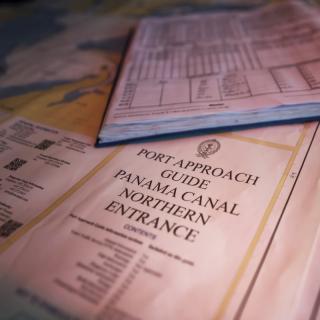Your Guide to the Panama Canal

Aboard E/V Nautilus we are busy preparing for our historic transit of the Panama Canal. This trip marks the first time Nautilus, in its mission of exploration, has crossed into the Pacific Ocean. To celebrate the crossing, we’ve outfitted the ship with a new forward-facing camera, and will be broadcasting that footage along with a live marine radio feeds from the ship during our crossing. The following list of canal fast facts is a primer for the voyage. We hope that you enjoy it, and that you join us for this exciting trip on Nautilus Live, Twitter, and Facebook. Use the map above as a reference if you would like to follow along.
Panama Canal: By The Numbers
Canal Length: 48 miles (77.1 kilometers)
Lock Width: 110 feet (33.5 meters)
Lock Length: 1050 feet (320 meters)
Elevation: 0 to 85 feet (26 meters) above sea-level
Annual Traffic: 14,702 vessels (as of 2008)
Historical Fast Facts
Dates of Construction:
1881–1894 (French Ownership)
1904–1914 (U. S. Ownership)
Principal Engineers:
John Findlay Wallace (1904–05)
John Frank Stevens (1905–07)
George Washington Goethals (1907–14)
First Trip: August 15, 1914
Canal Trivia
It takes about 52 million gallons of water to operate the locks for one ship’s passage through the Panama Canal
The first American plans for an Atlantic-Pacific canal were in Nicaragua, not Panama.
Approximately 30,000,000 pounds of explosives were used to build the canal.
The most expensive regular toll ever paid belongs to the cruise ship Norwegian Pearl, which paid US$375,600 on April 14, 2010.
The cheapest toll on record was paid by Richard Halliburton when he swam the Canal in 1928.
Death in the Canal
During the Canal’s construction, more than 25,000 lives were lost. Of these deaths, more than 20,000 occurred during the earlier French phase of construction, and were largely the result of insect-born diseases, namely yellow fever and malaria. Those workers lost during the deadliest period of construction are memorialized near the Cemeterio Frances outside Panama City.

Panama Canal Crossing & Transit to the Galapagos
Following our work in the Gulf of Mexico, the E/V Nautilus will transit from Galveston, TX to Panama and then transit through the Panama Canal, a historic crossing that signals the entry of Nautilus to its future work in the East Pacific region. The Panama Canal officially opened on August 15, 1914, one of the largest and most difficult engineering projects ever undertaken. The shorter, faster, and safer route to the U.S.





